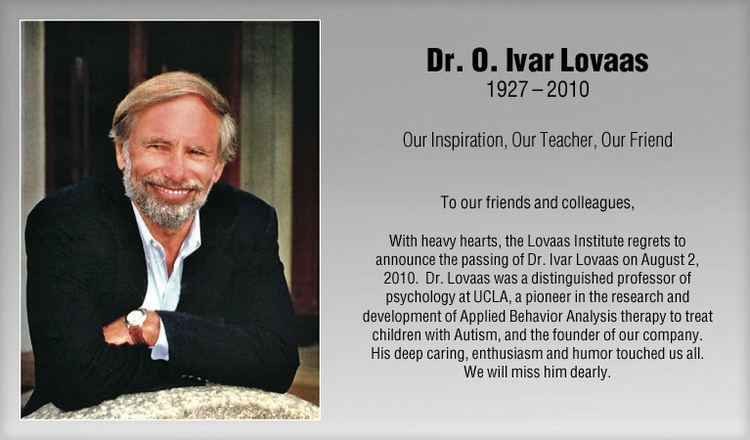Full Name Ole Ivar Lovaas Role Psychologist Name Ole Lovaas | Nationality Norwegian Books The autistic child | |
 | ||
Occupation Clinical Psychology Professor Awards Guggenheim Fellowship for Social Sciences, US & Canada | ||
Ole Ivar Lovaas Wikipedia Article Audio
Ole Ivar Løvaas PhD (8 May 1927 – 2 August 2010) was a Norwegian-American clinical psychologist and professor at the University of California, Los Angeles (UCLA). He is considered to be a pioneer within the field of applied behavior analysis (ABA) through his development of Discrete trial training (DTT), and was the first to provide evidence that the behavior of children with autism can be modified through teaching. In 1999, the U.S. Office of the Surgeon General described Lovaas's techniques as having been shown to be efficacious at "reducing inappropriate behavior and in increasing communication, learning, and appropriate social behavior" which is based on "thirty years of research."
Contents
- Ole Ivar Lovaas Wikipedia Article Audio
- Lovaas method
- Work with George Rekers on gender variant children
- Personal life
- References

Lovaas method

Dr. Ole Ivar Lovaas received his undergraduate degree in psychology in 1951 from Luther College and doctoral degree in clinical psychology in 1958 from the University of Washington where his work was influenced by early applied behavior analysts such as Sidney W. Bijou, Donald Baer, Montrose Wolf, Todd Risley and James Sherman. While overshadowed in the 1960s and 1970s by work in applied behavior analysis on schizophrenia, teaching models, and general developmental disabilities, Lovaas's intensive application of basic learning principles to autism has become the model for most current behavioral approaches to the condition. Findings of independent peer reviewed and replicated research studies associated with the Lovaas method, have shown that 47% of children can achieve normal functioning and subsequently succeed in regular education without assistance, 43% will make significant progress but continue to demonstrate language delays, 10% will make little progress, though some have disputed these findings. In his original studies in the late 1950s aversives such as electric shock successfully treated many individuals engaging in extreme self-injury (eye gouging, head banging) whose life expectancy was reduced by secondary infection. Subsequent studies were on extinction methods, in which attention is given only when persons are not engaging in self-injury. Lovaas's use of highly aversive methods, uncommon even in his time, are now very rarely used and controversial in the field.

The "Lovaas method" includes high treatment intensity up to 40-hours per week in a 1:1 teaching setting using discrete trials, treatment is done at home with parents involved in every aspect of treatment, the curriculum is highly individualized with a heavy emphasis on teaching language, and ABA principles are used to motivate learning and reduce non-desired behaviors. The "Lovaas Method" went on the become "Early Intensive Behavior Intervention" or "EIBI." In addition to being one of the founders of ABA, Dr. Lovaas taught now prominent behaviorists such as Robert Koegel, Laura Schreibman, Ted Carr, Ron Leaf, Tristram Smith, Doreen Granpeesheh, Jacquie Wynn, Annette Groen, John McEachin and over 20,000 students at UCLA who took his course during his 50 years of teaching. He contributed in major ways to the formation of the Autism Society of America (ASA), published hundreds of research articles and books, received state and national awards, and forced school districts to adopt evidenced based teaching programs. His work influenced how autism was treated, and improved the lives of parents and children stricken with the autism diagnosis worldwide.
The whole approach is disputed, though, by advocates of neurodiversity, such as Michelle Dawson or Ari Ne'eman, who claim it forces people to repress their true personalities on behalf of a narrow conception of normality. Edward K. Morris of the University of Kansas has argued that this position grossly misrepresents the actual goals of applied behavior analysis interventions and the standard practices of behavior analysts.
Work with George Rekers on gender-variant children
In addition to his extensive work with autistic children, in the 1970s Lovaas co-authored four papers with George Rekers on children with atypical gender behaviors. The subject of the first of these studies, a 'feminine' young boy who was homosexual of 4 and half years old at the inception of treatment, committed suicide as an adult; his family attribute the suicide to this treatment.
Following his suicide in 2010, the boys' sister told the news that she read his journal which described how he feared to ever disclose his sexual orientation because when receiving the behavior modification treatment as a young boy, his father would give him spankings if he was given a different color "poker chip" as punishment for feminine-like behavior.
Personal life
Lovaas was born in Lier, Norway and was a farm worker during the 1940s Nazi occupation of Norway. After the war, Lovaas earned a music scholarship to Luther College in the American state of Iowa. He earned his undergraduate degree at Luther College and his doctorate in psychology from the University of Washington. Married twice, Lovaas had four children from his first marriage and is survived by six grandchildren and three great-grandchildren.
